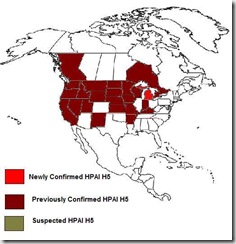 |
| Credit BHAH - 26 H5N8 Outbreaks In 2018 |
#13,687
HPAI H5N8 activity - outside of the Middle East and parts of Africa - has been on the decline for the past 18 months following its record setting European epizootic over the winter of 2016-2017.
The two exceptions being in Western Russia (see Brief ESA Report On HPAI H5N2 & H5Nx In Russia) and Bulgaria (see UK DEFRA: SitRep On HPAI H5N8 In Bulgaria).Two weeks ago Bulgaria's NVS Imposed Stricter Avian Flu Biosecurity Rules which spurred protests against the nation's Food Safety Agency (BHAH) (see Row over food safety agency’s tough measures against bird flu in Bulgaria).
Today that agency has published a summary of HPAI outbreaks in Bulgaria in 2018, while doubling down on the need for better biosecurity.
Enhanced surveillance of poultry farms continues
20.11.2018
26 are the confirmed outbreaks of Avian influenza in 5 administrative districts in the country
Enhanced surveillance and control of poultry establishments on the unfavorable epizootic situation in Bulgaria related to the bird flu disease continues. By Order No РД 11-2266 / 09.11.2018 and by Order No. РД 11-2267 / 09.11.2018 the additional measures for prevention, restriction and eradication of the disease Avian influenza are fixed.
By mid-November this year, 26 outbreaks of High Pathogenic Influenza have been confirmed (VAPP H5N8) in 5 administrative districts - Dobrich, Plovdiv, Haskovo, Stara Zagora and Yambol. The total number of birds in all affected poultry farms is over 1,000,000. 14 are outbreaks in milking duck breeding holdings, 6 in cowsheds (one on a broiler farm), 5 in back yards, 1 in a game farm.
The results so far have shown that virus circulation continues to exist in poultry farms. Major causes for the emergence and spread of Avian Influenza are breakthroughs in farm bio-security, outdoor poultry farming and biosecurity during bird transport.
The measures taken are aimed at early detection of virus-infected birds, prevention of the spread of the disease and protection of the poultry sector in the rest of the country. The strategy for control of the situation includes measures such as: biosecurity on farms; a higher frequency of laboratory control to prove lack of infection with the virus (increased number of official veterinary inspections); movement of birds into and from the protection and surveillance zones is not allowed, except in the exceptions prescribed by the legislation.
In order to prevent and control the disease, strict surveillance is carried out with clinical examinations at the poultry establishments located in the established protection and observation areas around the established outbreaks.
With the measures imposed, NVS aims to rescue the sector in relation to Influenza disease. The NVS also calls for self-control and the establishment of a branch organization to support the control activities carried out by the Agency. During the BATH-initiated multi-annual meetings with the poultry sector in the last two weeks, the Agency and the Poultry Industry agreed that supervision is necessary and should be strictly enforced. The participants in the workshops united around the fact that the measures are needed to preserve the international markets of the poultry industry, to provide a normal atmosphere for the operation of the farms with birds and to guarantee the safety of the Bulgarian consumer.
Meanwhile, in connection with the complicated epizootic situation regarding the bird flu, the European Commission (EC) raised the issue of expanding the current containment zones and creating an additional restrictive zone in the country, including the territory of the districts of Plovdiv, Haskovo and part of Stara Zagora.
The EC's reasoning is mainly related to the increase in the number of outbreaks since the beginning of October 2018, the outbreak of outbreaks in the same poultry sector, the high risk season beginning with the disease, the need to provide guarantees to Member States and third countries in relation to the movement of live poultry and hatching eggs.(Continue . . . )
The BSA has proposed to the EC that the option of creating an additional area should be considered after a final analysis of the results of the enhanced surveillance currently in place and the implementation of the commitments made by the poultry sector to strengthen farms.
Up-to-date information on outbreaks of bird flu Influenza in the country can be found in the interactive map published on the site of BSAF here .
While there are understandable concerns over the local spread of the virus, as we discussed a couple of weeks ago in WHO: Migratory Birds & The Potential Spread Of Avian Influenza, both Bulgaria and Western Russia lie under the Black Sea/ Mediterranean Flyway, which funnels birds to Western Europe, the Middle East, and Africa.
These flyways often overlap, providing a way for birds - and the viruses they sometimes carry - to spread laterally, as well as north to south. Reservoirs of the virus, therefore, have the potential to spread.
While Europe has borne the brunt of epizootic H5Nx the past several winters, in 2014-15 it was North America's turn, after the virus jumped from Asia to the Pacific Northwest - and beyond.The virus was carried - primarily by migratory birds - to 15 states, where more than 220 farms were infected and more than 50 million commercially raised birds were lost or destroyed.
 |
| HPAI H5Nx Status July 2015 |
Just as in Europe, there is a need to bolster biosecurity here in the United States, as we can never know when the next avian flu virus will arrive. To that end, next week the USDA will hold a free webinar on ways to protect poultry by increasing biosecurity.
Whether you are a large commercial poultry operation, or simply keep a few backyard birds, it is important to become a Flock Defender. The USDA urges:
Biosecurity is the key to keeping our nation’s poultry healthy. It’s a responsibility that we all share. Working together, we can defend all flocks from avian influenza and other infectious diseases.

